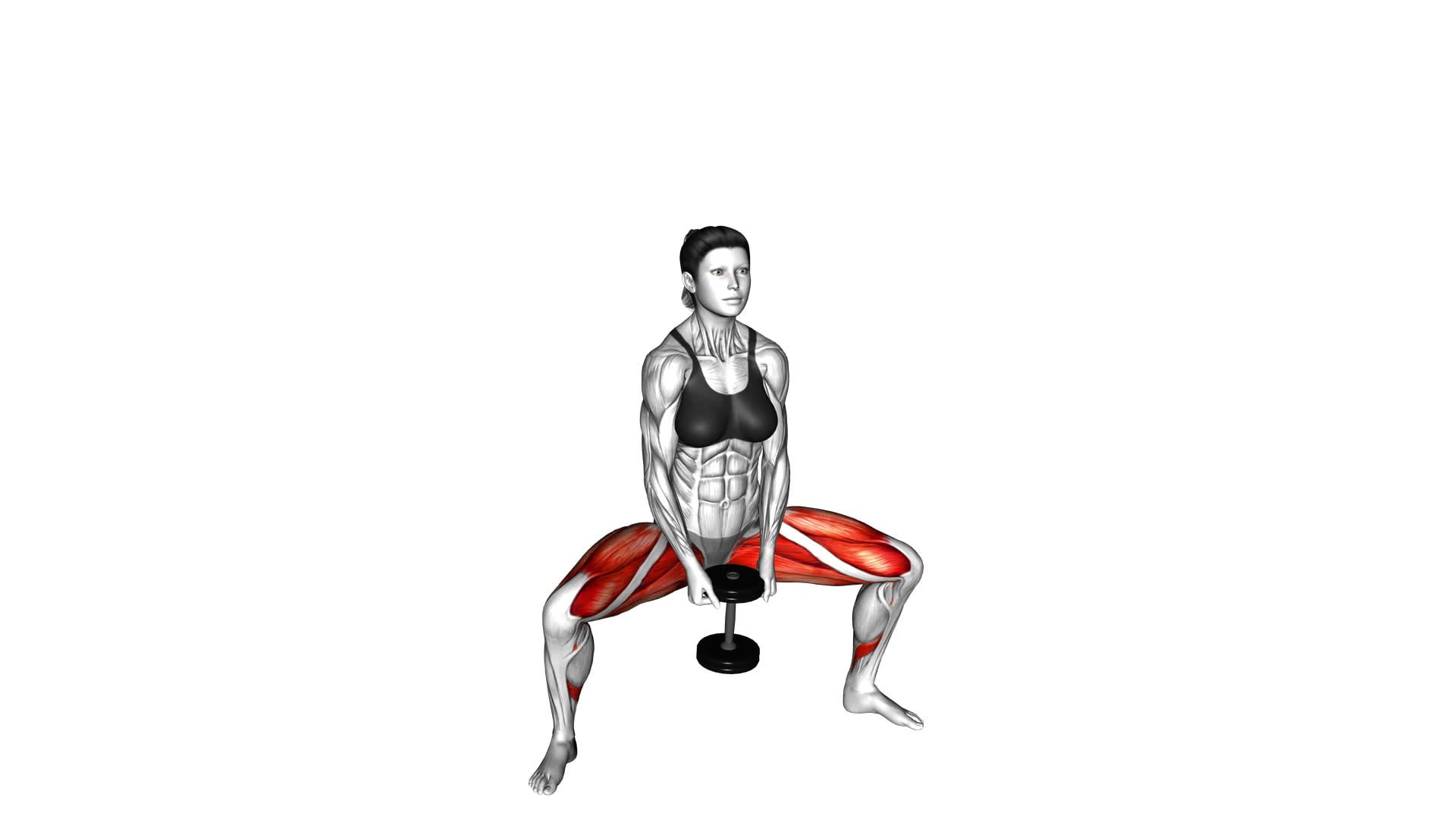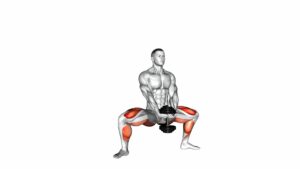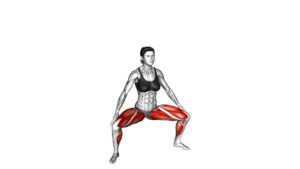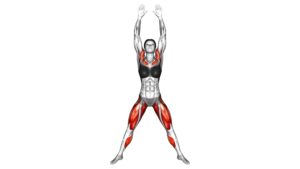Dumbbell Plyo Squat (female) – Video Exercise Guide & Tips

Get ready to add some power to your leg workout with the dumbbell plyo squat!
Watch This Exercise Video
In this video exercise guide, we'll show you how to perform this explosive move with proper form and technique.
You'll also learn how to choose the right dumbbell weight and discover variations to keep challenging yourself.
Increase the intensity of your squats and avoid common mistakes with our expert tips.
Get ready to feel the burn and see results with this effective exercise!
Key Takeaways
- Dumbbell plyo squats enhance athleticism and effectively burn calories.
- They target multiple muscle groups including quadriceps, hamstrings, glutes, and calves.
- Engaging fast-twitch muscle fibers improves power and explosiveness.
- Adding resistance from dumbbells increases calorie burn and aids in weight loss and overall fitness improvement.
Benefits of Dumbbell Plyo Squats
Experience the explosive power and full-body benefits of dumbbell plyo squats. Incorporating dumbbells into your plyometric squats can take your workout to the next level, helping you improve athleticism and burn calories more effectively.
Dumbbell plyo squats target multiple muscle groups, including your quadriceps, hamstrings, glutes, and calves. The explosive nature of the exercise engages your fast-twitch muscle fibers, enhancing your power and explosiveness. This translates to improved athletic performance, whether you're a runner, a basketball player, or an everyday fitness enthusiast.
Additionally, dumbbell plyo squats are a great way to increase your calorie burn. The combination of the squat movement and the added resistance from the dumbbells increases the intensity of the exercise, causing your body to work harder and burn more calories. This can be especially beneficial if you're looking to lose weight or improve your overall fitness level.
To maximize the benefits of dumbbell plyo squats, it's important to maintain proper form. Start by standing with your feet shoulder-width apart, holding dumbbells at your sides. Lower into a squat position, keeping your chest up and your knees tracking over your toes. Explosively jump up, pushing through your heels, and land softly back into the squat position. Repeat for the desired number of repetitions.
Incorporating dumbbell plyo squats into your workout routine can help you improve athleticism and torch calories. Give it a try and experience the full-body benefits for yourself.
Proper Form and Technique
To perform the dumbbell plyo squat with proper form and technique, you should frequently focus on your stance, explosiveness, and landing. Here are some tips to help you achieve the correct form and prevent injuries:
- Stance: Start with your feet shoulder-width apart and toes slightly turned out. This will provide a stable base for the exercise and ensure proper alignment throughout the movement.
- Explosiveness: The key to the plyometric aspect of this exercise is the explosive jump. Push through your heels and use your glutes and quads to propel yourself upwards. Aim to maximize your jump height while maintaining control.
- Landing: When you land, make sure to absorb the impact by bending your knees and hips. This will help prevent excessive stress on your joints. Land softly and quietly, focusing on a controlled descent.
- Common Mistakes: Avoid rounding your back or allowing your knees to cave inwards during the squat. These mistakes can put unnecessary strain on your spine and knees, increasing the risk of injury.
- Injury Prevention: It's crucial to warm up properly before performing plyometric exercises like the dumbbell plyo squat. This helps prepare your muscles and joints for the explosive movements, reducing the risk of strains or sprains.
Choosing the Right Dumbbell Weight
When choosing the right dumbbell weight, there are a few points to consider.
For beginners, it's important to start with a weight that allows you to maintain proper form and technique without straining yourself.
As you progress, gradually increase the weight to continue challenging your muscles.
Ultimately, the right dumbbell weight will depend on your individual strength levels and goals.
Weight for Beginners
Start with a dumbbell weight that feels challenging but manageable for you. Choosing the right weight is essential for beginners to ensure that you can perform exercises correctly and safely. Here are some tips to help you select the appropriate weight:
- Consider your fitness level: If you're just starting out, it's best to begin with lighter weights and gradually increase as you get stronger.
- Focus on proper form: Make sure you can maintain proper form throughout the exercise without compromising your technique.
- Listen to your body: Pay attention to how your body feels during the exercise. If the weight feels too heavy or causes pain, it's a sign that you should use a lighter weight.
- Seek professional guidance: If you're unsure about the weight selection, consult a fitness professional who can provide expert advice tailored to your individual needs.
Progressively Increasing Weights
As you progress in your fitness journey, it's important to gradually increase the weight of your dumbbells to continue challenging your muscles and promoting growth. This concept is known as progressive overload, which involves increasing the resistance placed on your muscles over time.
By gradually increasing the weight of your dumbbells, you can ensure that your muscles are constantly being challenged and forced to adapt. This will help you build strength and muscle mass more effectively.
When choosing the right dumbbell weight, it's important to start with a weight that allows you to perform exercises with proper form and technique. From there, you can gradually increase the weight as you become stronger and more comfortable with the exercises.
Individual Strength Levels
To choose the right dumbbell weight for your individual strength level, assess your current capabilities and select a weight that challenges you without sacrificing proper form. It's important to find the balance between pushing yourself and maintaining good technique. Here are some tips to help you choose the appropriate weight:
- Start with a weight that allows you to perform the exercise with proper form for the desired number of repetitions.
- Gradually increase the weight as you get stronger and more comfortable with the exercise.
- Use progress tracking tools, such as a training log or app, to keep track of your weights and monitor your progress over time.
- Consider working with a personal trainer to receive personalized training and guidance.
By following these guidelines, you can ensure that you're using the right dumbbell weight for your current strength level, enabling you to progress effectively in your fitness journey.
Now, let's move on to discussing variations and modifications of the dumbbell plyo squat.
Variations and Modifications
Now, let's talk about the different variations and modifications you can make to the dumbbell plyo squat exercise. These variations cater to different skill levels, allowing you to progress or regress the movement according to your abilities.
Additionally, if you don't have access to dumbbells, there are alternative equipment options you can use to still perform a plyometric squat.
Lastly, it's important to consider any injuries or limitations you may have and make modifications accordingly to ensure a safe and effective workout.
Different Skill Levels
Mastering the dumbbell plyo squat requires gradually increasing intensity and incorporating variations and modifications to cater to your skill level. Whether you're a beginner or an advanced fitness enthusiast, there are different progression levels and modifications available to help you improve and challenge yourself.
Here are some options to consider:
- Start with bodyweight squats: If you're new to plyometrics or strength training, begin by practicing regular squats without weights. This will help you build a solid foundation and work on your form.
- Use lighter dumbbells: As you progress, you can incorporate light dumbbells into your squats to add resistance and increase the difficulty.
- Incorporate jump squats: For more advanced individuals, you can add an explosive element to your squats by including jump squats. This will enhance power and explosiveness in your lower body.
- Try single-leg squats: To further challenge your stability and balance, you can progress to performing the dumbbell plyo squat on a single leg. This variation targets your muscles in a different way and increases the difficulty of the exercise.
Remember to listen to your body and progress at a pace that feels comfortable for you.
Equipment Alternatives
As you progress in your dumbbell plyo squat journey, you can explore various equipment alternatives, modifications, and variations to challenge yourself further.
When it comes to equipment options, you can use different types of weights, such as kettlebells or resistance bands, to add resistance and intensity to your squats. These alternatives can help target different muscle groups and provide a fresh challenge to your workout routine.
Additionally, if you have any injuries or limitations, there are modifications available to ensure you can still perform the exercise safely and effectively. For example, if you have knee issues, you can perform a modified version of the squat by using a stability ball against a wall for support.
It's important to listen to your body and make necessary adjustments to accommodate any injuries or limitations you may have.
Injury Considerations
To accommodate any injuries or limitations, you can make variations and modifications to the dumbbell plyo squat exercise. It's important to prioritize safety and injury prevention when engaging in any physical activity. Here are some considerations to keep in mind:
- Reduce the weight: If you have a pre-existing injury or are recovering from one, it may be necessary to use lighter dumbbells or even no weights at all during the exercise.
- Decrease the intensity: Instead of jumping explosively during the squat, you can modify the movement by performing regular squats without the plyometric element.
- Modify the range of motion: If you have knee or hip issues, you can perform partial squats, limiting the depth to a comfortable level that doesn't cause pain or discomfort.
- Use a stability aid: If you struggle with balance or have ankle instability, using a stability aid, such as a chair or wall, can provide support during the exercise.
Remember to consult with a healthcare professional or a certified trainer before attempting any modifications to ensure they're appropriate for your specific condition or injury.
Tips for Increasing Intensity
To increase the intensity of the dumbbell plyo squat, gradually add more weight to challenge and strengthen your muscles. This technique, known as progressive overload, involves increasing the resistance over time to continue making progress and avoid plateaus. By increasing the weight of the dumbbells, you'll force your muscles to work harder, leading to greater gains in strength and power.
In addition to adding more weight, you can also increase the intensity by incorporating explosive movements into your plyometric squats. Explosive movements involve quick, powerful bursts of energy, which can further challenge your muscles and improve your overall athleticism. For example, you can perform the plyo squat with a jump, exploding upward as you rise from the squat position. This will engage your fast-twitch muscle fibers and enhance your explosive power.
By gradually increasing the weight and incorporating explosive movements, you can take your dumbbell plyo squats to the next level and maximize your results. Remember to always use proper form and technique to avoid injury and get the most out of your workouts.
Now that you know how to increase the intensity of the dumbbell plyo squats, let's move on to the next section and discuss common mistakes to avoid.
Common Mistakes to Avoid
To avoid common mistakes and ensure proper form, focus on maintaining good balance and stability throughout the dumbbell plyo squat. This won't only help you avoid injuries but also improve your balance over time.
Here are some common mistakes to avoid:
- Leaning too far forward: It's important to keep your torso upright during the exercise. Leaning too far forward can put unnecessary strain on your lower back and increase the risk of injury.
- Allowing your knees to cave in: Keep your knees in line with your toes throughout the movement. Allowing your knees to cave in can lead to knee pain and instability.
- Using too much weight: It's important to start with a weight that you can handle with proper form. Using too much weight can compromise your technique and increase the risk of injury.
- Neglecting to warm up: Before performing any plyometric exercise, it's crucial to warm up properly. This helps to prepare your muscles and joints for the explosive movements, reducing the risk of injury.
Frequently Asked Questions
How Many Calories Can I Burn by Doing Dumbbell Plyo Squats?
If you're wondering how many calories you can burn by doing dumbbell plyo squats, the answer depends on the intensity level. The more effort you put in, the more calories you'll burn.
To maximize the calorie burn, you can also combine dumbbell plyo squats with other exercises in a well-rounded weight loss workout. This will help you achieve your goals effectively.
Keep pushing yourself and stay consistent for the best results.
Can Dumbbell Plyo Squats Help Me Lose Weight?
Dumbbell plyo squats can definitely help you lose weight. Incorporating plyometric exercises, like plyo squats, into your workout routine can increase your calorie burn and boost your metabolism. These explosive movements engage multiple muscle groups and require a lot of energy, which can aid in weight loss.
To modify dumbbell plyo squats for different fitness levels, you can adjust the weight of the dumbbells or modify the depth and speed of the squat.
Can I Do Dumbbell Plyo Squats if I Have Knee or Hip Pain?
If you're experiencing knee or hip pain, modifications can be made to dumbbell plyo squats. It's important to listen to your body and avoid exercises that cause discomfort.
Consult with a healthcare professional or a qualified trainer to learn modifications that are suitable for your condition.
Incorporating dumbbell plyo squats into a rehabilitation program can have benefits such as improving strength and stability in the lower body.
How Often Should I Incorporate Dumbbell Plyo Squats Into My Workout Routine?
To effectively incorporate dumbbell plyo squats into your workout routine, consider adding them to other lower body exercises. This can help to target multiple muscle groups and enhance overall strength and power.
Additionally, incorporating plyo squats into a cardio routine can provide added benefits such as increased calorie burn and improved cardiovascular fitness.
Aim to perform dumbbell plyo squats 2-3 times a week, allowing for proper rest and recovery between sessions.
Are Dumbbell Plyo Squats Suitable for Beginners or Should I Have Prior Strength Training Experience?
Dumbbell plyo squats can be challenging for beginners without prior strength training experience. It's important to gradually build up your strength and stability before attempting this exercise. If you're a beginner, consider starting with bodyweight squats or using lighter weights.
Focus on proper form and technique to avoid injury. As you progress, you can gradually increase the weight and intensity of the exercise. Remember to listen to your body and modify or choose alternative exercises as needed.
Conclusion
In conclusion, incorporating dumbbell plyo squats into your workout routine can provide numerous benefits, such as improved lower body strength and power. By maintaining proper form and technique, selecting the appropriate dumbbell weight, and making variations and modifications as needed, you can maximize the effectiveness of this exercise.
Additionally, by following tips for increasing intensity and avoiding common mistakes, you can ensure a safe and efficient workout.
So, grab those dumbbells and start squatting for a stronger and more toned physique.

Author
Years ago, the spark of my life’s passion ignited in my mind the moment I stepped into the local gym for the first time. The inaugural bead of perspiration, the initial endeavor, the very first surge of endorphins, and a sense of pride that washed over me post-workout marked the beginning of my deep-seated interest in strength sports, fitness, and sports nutrition. This very curiosity blossomed rapidly into a profound fascination, propelling me to earn a Master’s degree in Physical Education from the Academy of Physical Education in Krakow, followed by a Sports Manager diploma from the Jagiellonian University. My journey of growth led me to gain more specialized qualifications, such as being a certified personal trainer with a focus on sports dietetics, a lifeguard, and an instructor for wellness and corrective gymnastics. Theoretical knowledge paired seamlessly with practical experience, reinforcing my belief that the transformation of individuals under my guidance was also a reflection of my personal growth. This belief holds true even today. Each day, I strive to push the boundaries and explore new realms. These realms gently elevate me to greater heights. The unique combination of passion for my field and the continuous quest for growth fuels my drive to break new ground.







